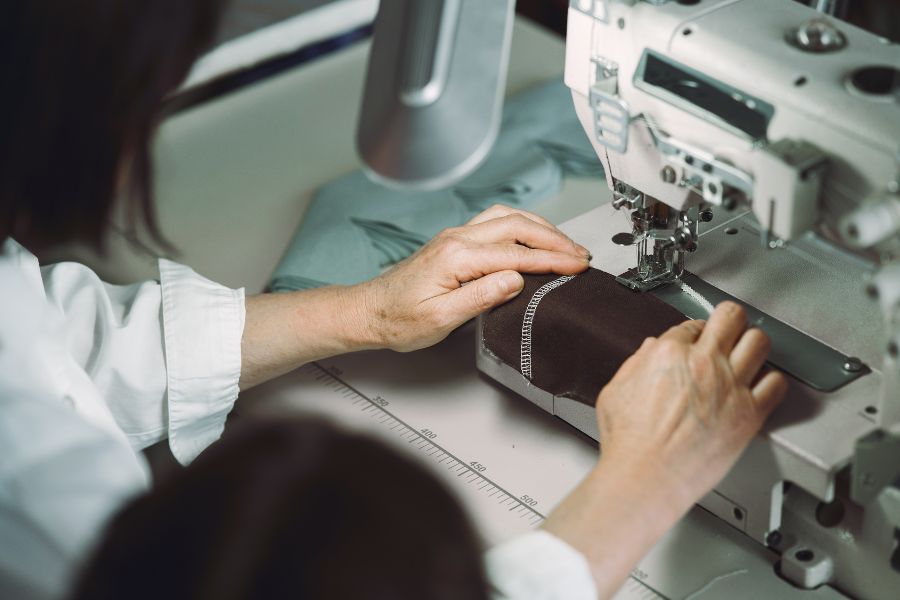Embarking on the transformation from concept to creation, this article explores the intricate stages of clothing manufacture. From design sketches to final stitches, uncover the secrets behind bringing fashion to life. Discover the fascinating world of pattern making, fabric sourcing, cutting, sewing, and quality control. Whether it’s the fast-paced fashion supply chain or the rise of sustainable practices, join us on the captivating journey of clothing manufacture.
The Stages of Clothing Manufacture
Here are the typical stages involved in clothing manufacture:
- Design and Concept Development: The process starts with designing and conceptualizing the clothing. This includes creating sketches, selecting fabrics, colors, and patterns, and developing a clear vision of the desired end product.
- Pattern Making: Once the design is finalized, a pattern maker creates paper or digital patterns based on the design specifications. Patterns use as templates for cutting the fabric.
- Sample Making: Samples are created to test the design and fit of the garment. They are made using patterns and selected fabrics. Several iterations may be required to attain the desired result.
- Fabric Sourcing: Fabrics are sourced from suppliers based on the requirements of the design. This involves selecting appropriate materials in terms of quality, color, texture, and performance.
- Cutting: The fabric is spread out in layers, and the patterns are placed on top. Then, the fabric is cut along the outlines of the designs. This can be done manually or with the help of computerized cutting machines.
- Sewing: The cut fabric pieces are then stitched together to create the garment. This process is usually done in assembly lines or production units. Skilled sewing operators operate sewing machines to join the fabric pieces and add components like zippers, buttons, and trimmings.
- Fitting and Quality Control: Throughout the production process, garments are periodically checked for fit, quality, and consistency. Fittings are conducted to ensure the garments meet the desired measurements and specifications.
- Finishing: After sewing, the clothing goes through several finishing steps.. This may include pressing/ironing, trimming loose threads, attaching labels and tags, adding buttons or other fasteners, and any necessary alterations or adjustments.
- Packaging and Labeling: Once the garments pass the quality control and finishing stages, they are packaged and labeled for shipment. Packaging may involve folding, poly bagging, and boxing the garments, while labeling includes adding size labels, care instructions, and branding elements.
- Distribution and Retail: The final stage involves distributing the manufactured clothing to retailers or directly to customers. The garments may be shipped to stores or warehouses, or they may be sold through online platforms or brick-and-mortar stores.
It’s important to note that the clothing manufacturing process can be complex and involve collaboration among designers, pattern makers, fabric suppliers, cutters, sewers, quality control inspectors, and other professionals depending on the scale of production and the company’s structure.
Two Approaches of Clothing Manufacture
The global apparel industry, a complex, giant machine that churns out billions of clothing articles and accessories, reaching billions of consumers worldwide, generated over 1.5 trillion U.S. dollars in market revenue in 2022. Within this industry, there are two main approaches to clothing manufacture: a fast approach and a slow and sustainable approach to the fashion supply chain.
Fast Approach to the Fashion Supply Chain
The fast approach to clothing manufacturing emphasizes speed and efficiency in the production process. It is characterized by rapid turnaround times, high volumes of production, and quick delivery to meet consumer demand for fast fashion. Key features of this approach include:
- Quick Design-to-Market: Designs are rapidly developed and translated into production to capture current trends and capitalize on consumer demand.
- Mass Production: Garments are produced in large quantities using standardized processes and assembly-line methods.
- Low Cost: Cost reduction strategies are employed, often involving outsourcing to low-wage countries and utilizing inexpensive materials.
- Short Production Lead Times: Manufacturers aim to reduce the time between the initial order placement and the delivery of the final products to retailers or consumers.
- High Turnover: Fast-fashion brands introduce new collections frequently, encouraging consumers to make frequent purchases to stay up to date with the latest trends.
Slow Approach to the Fashion Supply Chain
The slow and sustainable approach to clothing manufacturing focuses on ethical production practices, environmental sustainability, and a long-term perspective. It seeks to address the negative impacts of fast fashion and promote responsible consumerism. This strategy is critical in light of the predicted 1.6 gigatonnes of carbon dioxide equivalents produced by garment manufacture and retail in 2030 if nothing substantial changes in the industry’s operations.
- Ethical and Transparent Practices: Manufacturers prioritize fair labor conditions, workers’ rights, and transparency in the supply chain.
- Sustainable Materials: Environmentally friendly and socially responsible materials are preferred, such as organic cotton, recycled fabrics, and innovative eco-friendly alternatives.
- Quality and Durability: Emphasis is placed on creating well-made, durable garments that can withstand multiple wears and washes, reducing the need for frequent replacements.
- Local and Artisanal Production: The focus is on supporting local artisans and small-scale manufacturers, promoting craftsmanship and traditional techniques.
- Reduced Waste and Recycling: Efforts are made to minimize waste through efficient production processes and recycling initiatives, including upcycling or repurposing materials.
- Slower Production Cycles: Rather than following fast fashion’s rapid turnover, slower production cycles allow for more thoughtful and deliberate design and production decisions.
These two approaches represent contrasting philosophies within the clothing manufacturing industry, with the fast approach prioritizing speed and profit, while the slow and sustainable approach focuses on ethics, sustainability, and long-term impact.
Conclusion
Clothing manufacture, a complex journey that brings design concepts to life, involves stages such as pattern making, fabric sourcing, cutting, sewing, and quality control. From sketch to stitch, this process showcases the craftsmanship and creativity behind the creation of everyday garments. As the final step to complete this journey and reach multi-channel customers, ConnectPOS plays a crucial role in helping to bring the products to customers, ensuring a seamless experience across the omnichannel. If you want to know more about this information, feel free to contact us.



